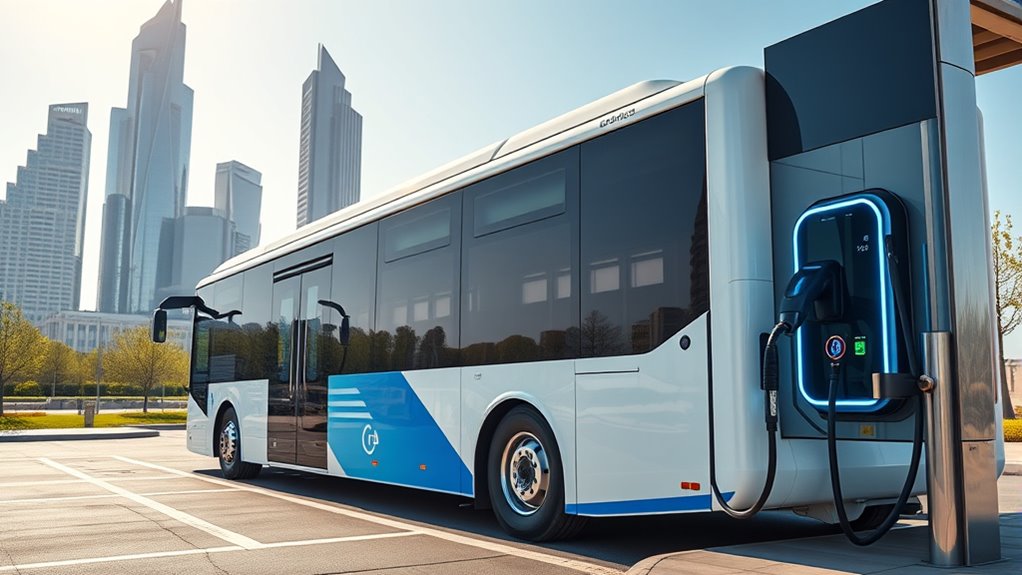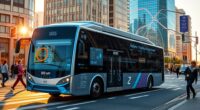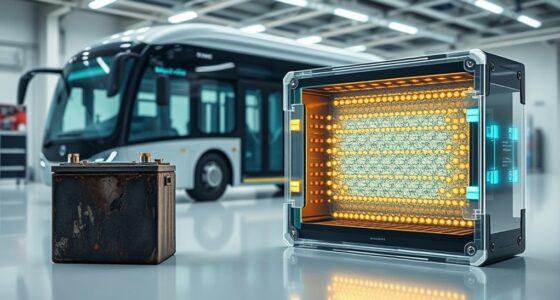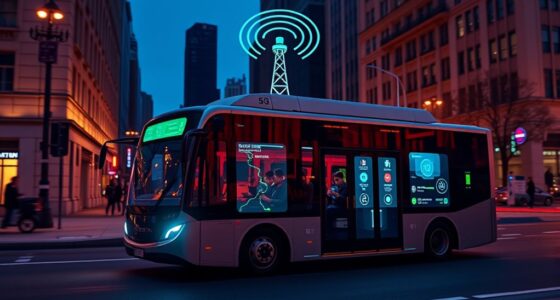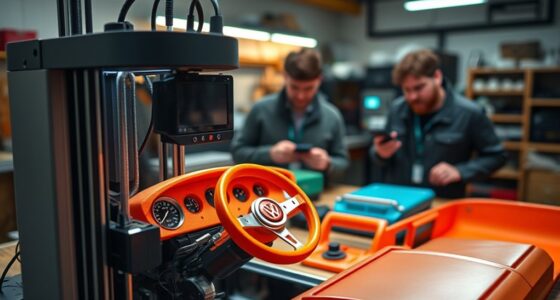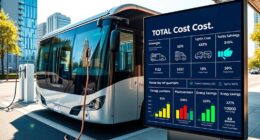Advancements in fast-charging technology are making electric buses more practical by enabling 10-minute top-ups, thanks to high-capacity power systems and improved battery chemistries like niobium-enhanced cells. Innovative solutions like 1MW chargers, pantograph systems, and modular battery swaps allow quick turnaround times during stops. These developments help reduce route disruptions and improve efficiency. To discover how these innovations are shaping the future of electric bus transit, stay with us for more details.
Key Takeaways
- Battery innovations like NTO and niobium-enhanced cells enable 10-minute rapid charging for electric buses.
- High-capacity, megawatt-level chargers support quick top-ups during short stops for urban and intercity routes.
- Use of off-the-shelf cells and scalable manufacturing reduces costs and supports higher charge rates, such as 10C.
- Advanced thermal management and real-time monitoring improve reliability during ultra-fast charging cycles.
- Global collaborations and local infrastructure projects accelerate deployment of fast-charging systems worldwide.
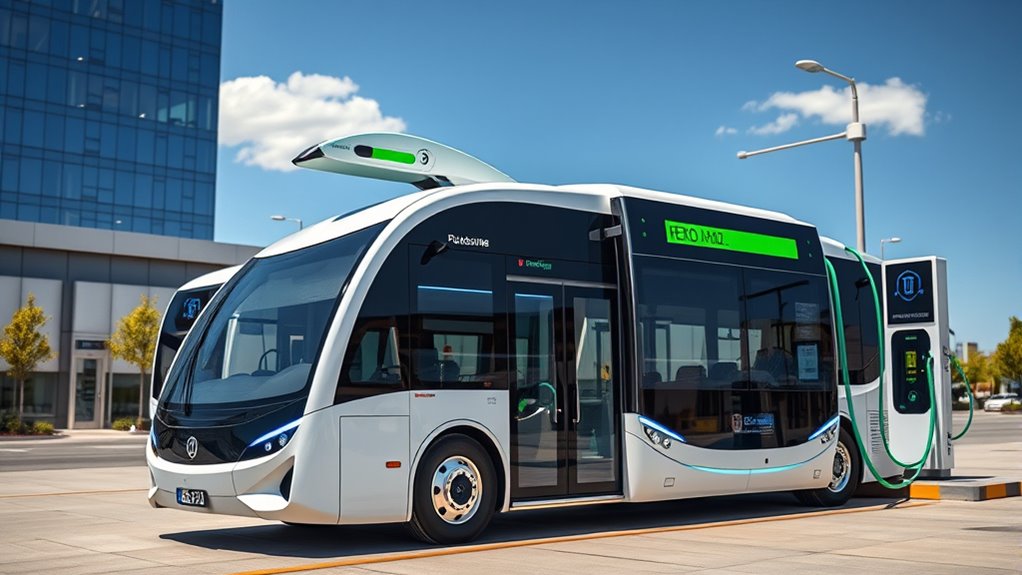
Recent advancements in fast-charging technology are transforming electric bus operations, making rapid turnaround times a practical reality. Thanks to innovative battery chemistries like NTO anode batteries, you can now charge an electric bus in just 10 minutes. This breakthrough, achieved through collaborations like Toshiba, Sojitz, and CBMM, considerably reduces downtime and aligns charging schedules with driver breaks, ensuring buses spend more time on the road. Rapid charging capabilities are becoming more reliable as thermal management systems improve to handle increased power loads efficiently.
Charge electric buses in just 10 minutes with innovative NTO anode batteries, reducing downtime and increasing on-road time.
Niobium-enhanced batteries further improve thermal stability and energy density, enabling high-power charging without risking overheating or battery degradation. These improvements mean your fleet can handle frequent, rapid charges safely and efficiently. Additionally, advancements in battery cell manufacturing are supporting higher charge rates and longer cycle life, making ultra-fast charging more practical for large-scale deployment.
You’ll also find that using standard off-the-shelf cells, as promoted by companies like Exponent Energy, simplifies manufacturing and reduces costs while supporting ultra-fast charging capabilities. This approach eliminates the need for proprietary designs, making advanced battery technology more accessible.
For intercity buses, 1MW charging systems—developed by Exponent and Veera Vahana—offer scalable solutions that can quickly replenish large battery packs, supporting longer routes and higher service frequencies. Cell material advancements, such as 10C charge rates, are essential for ultra-fast charging; India, for example, is actively pursuing domestic cell partnerships to strengthen local supply chains and accelerate deployment.
High-power charging infrastructure is catching up with these battery innovations. Megawatt-level chargers, ranging from 1MW to 1.5MW, are emerging for buses, drastically cutting charging times and reducing route interruptions. Major players like ABB and Siemens are delivering fast-charging solutions capable of supporting urban and intercity networks.
Pantograph systems integrated with overhead infrastructure enable rapid in-depot top-ups, while pilot projects explore dynamic charging options that allow buses to recharge opportunistically during scheduled stops. Prioritizing scalable grid integration ensures your charging stations won’t destabilize local power networks despite the high power demands.
Operational efficiency benefits from these technological leaps. You can schedule 10-minute charging cycles during driver breaks, minimizing route disruptions. Bidirectional or Vehicle-to-Grid (V2G) charging allows buses to feed power back into the grid during peak demand, creating additional revenue streams.
Predictive energy management software optimizes charging based on route topography and traffic conditions, ensuring batteries are always ready when needed. Modular battery swaps, tested in pilot programs, could further slash depot replenishment times to under 15 minutes. Real-time battery health monitoring systems help prevent degradation and faults caused by fast-charging stress, maintaining fleet reliability over time.
Globally, collaborations and prototypes demonstrate the broad potential of these technologies. Brazilian prototypes using NTO batteries, India’s deployment of 1MW chargers, and Chinese manufacturers leading in high-capacity hardware set global benchmarks. Additionally, the integration of advanced battery chemistries is critical for achieving these rapid-charging capabilities efficiently.
Frequently Asked Questions
What Are the Safety Concerns With High-Voltage Fast Chargers?
You should be aware that high-voltage fast chargers pose safety concerns like electrical shocks and potential battery fires. To stay safe, guarantee proper installation, regular maintenance, and follow emergency procedures.
Always use visible high-voltage components as a warning, and train staff to handle these systems correctly. Compliance with safety regulations is vital to prevent accidents and protect everyone involved in charging and operating electric buses.
How Do Fast-Charging Stations Impact Urban Traffic Flow?
Fast-charging stations impact urban traffic flow like a busy intersection, where careful management prevents chaos. They can reduce congestion by strategically locating stations in high-demand spots, cutting down detours.
However, they might cause slight delays or rerouting, especially if traffic reroutes around busy chargers. Using real-time traffic data helps plan placements, ensuring chargers help ease traffic rather than add to congestion, making city travel smoother.
What Are the Environmental Impacts of Increased Fast-Charging Infrastructure?
You might wonder about the environmental impacts of increased fast-charging infrastructure. It helps reduce greenhouse gas emissions and improves air quality by supporting electric buses.
It also uses energy efficiently, integrates with renewable sources, and requires less maintenance.
However, it raises concerns about electronic waste, battery recycling, and resource sourcing.
How Do Battery Degradation Rates Compare With Fast Versus Slow Charging?
You’re wondering how fast and slow charging affect battery degradation. Fast charging generates more heat and cyclic stress, which accelerates aging and shortens battery lifespan.
Slow charging produces less heat and mechanical stress, helping batteries last longer.
To maximize battery health, limit fast charging use, especially in hot conditions, and stay within ideal state-of-charge ranges.
Regular maintenance and temperature management also help slow degradation, saving you money over time.
What Are the Costs Associated With Installing Fast-Charging Stations?
You should know that installing fast-charging stations can be costly, ranging from $1 million to $2 million per station. The expenses include high-capacity transformers, electrical upgrades, site preparation, permits, and installation.
Location and infrastructure challenges further influence costs. These investments are significant, but long-term benefits like reduced fuel and maintenance costs, along with government incentives, can help offset the initial expenses.
Conclusion
So, congratulations! Now, you can impress your friends with your electric bus knowledge while waiting five minutes for a full charge—because who needs traditional charging times anyway? With all these advancements, you’ll soon be zipping around in buses that charge faster than you can finish your coffee. Just imagine telling your kids about the days when buses took hours to refill—what a quaint little inconvenience that was. Welcome to the future, where waiting is almost a thing of the past!
